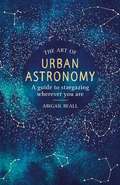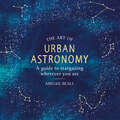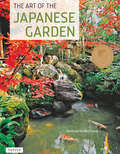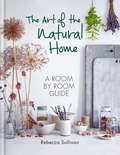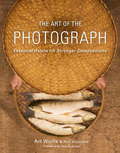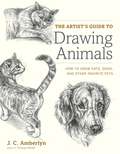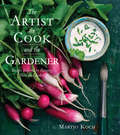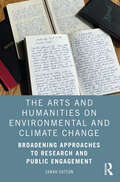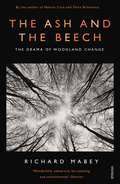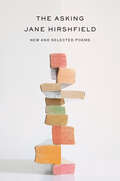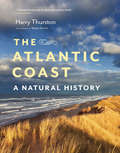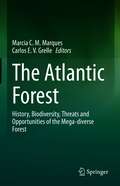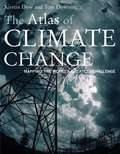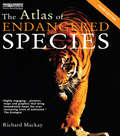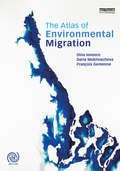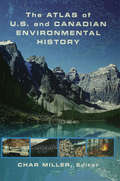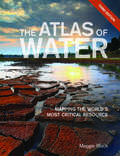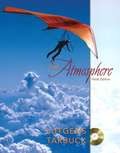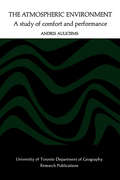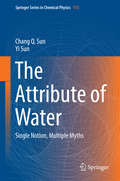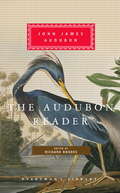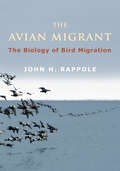- Table View
- List View
The Art of Urban Astronomy: A Guide to Stargazing Wherever You Are
by Abigail BeallDid you know that stars are seasonal? That Orion is one of the brightest constellations? That a single day on Venus is longer than an entire year on Venus? Space has captivated mankind since the beginning of time. Fifty years ago, Neil Armstrong became the first man to step on the moon and since then our knowledge of astronomy has continued to expand. With so many mysteries yet to be solved, science journalist Abigail Beall takes readers on an astonishing journey though the landscape of space. In The Art of Urban Astronomy, you will be guided through the seasons and learn about the brightest stars and constellations, the myths and legends of astronomy and how to identify star clusters and galaxies with just your eyes or a pair of binoculars. For urban dwellers wrapped up in the rush and bustle of the city, it can be calming and truly valuable to take the time simply to stop, look and reconnect with nature. Packed full of seasonal star charts, constellation charts and fascinating facts, this is the perfect guide for those who have looked up at the night sky and don't know where to begin. After reading this book, you'll never look up in the same way again.
The Art of Urban Astronomy: A Guide to Stargazing Wherever You Are
by Abigail BeallDid you know that stars are seasonal? That Orion is one of the brightest constellations? That a single day on Venus is longer than an entire year on Venus? Space has captivated mankind since the beginning of time. Fifty years ago, Neil Armstrong became the first man to step on the moon and since then our knowledge of astronomy has continued to expand. With so many mysteries yet to be solved, science journalist Abigail Beall takes readers on an astonishing journey though the landscape of space. In The Art of Urban Astronomy, you will be guided through the seasons and learn about the brightest stars and constellations, the myths and legends of astronomy and how to identify star clusters and galaxies with just your eyes or a pair of binoculars. For urban dwellers wrapped up in the rush and bustle of the city, it can be calming and truly valuable to take the time simply to stop, look and reconnect with nature. Packed full of seasonal star charts, constellation charts and fascinating facts, this is the perfect guide for those who have looked up at the night sky and don't know where to begin. After reading this book, you'll never look up in the same way again.
The Art of Urban Astronomy: A Guide to Stargazing Wherever You Are
by Abigail BeallDid you know that stars are seasonal? That Orion is one of the brightest constellations? That a single day on Venus is longer than an entire year on Venus? Space has captivated mankind since the beginning of time. Fifty years ago, Neil Armstrong became the first man to step on the moon and since then our knowledge of astronomy has continued to expand. With so many mysteries yet to be solved, science journalist Abigail Beall takes readers on an astonishing journey though the landscape of space. In The Art of Urban Astronomy, you will be guided through the seasons and learn about the brightest stars and constellations, the myths and legends of astronomy and how to identify star clusters and galaxies with just your eyes or a pair of binoculars. For urban dwellers wrapped up in the rush and bustle of the city, it can be calming and truly valuable to take the time simply to stop, look and reconnect with nature. Packed full of seasonal star charts, constellation charts and fascinating facts, this is the perfect guide for those who have looked up at the night sky and don't know where to begin. After reading this book, you'll never look up in the same way again.
The Art of the Japanese Garden
by David Young Michiko Young Tan Hong YewWinner of the 2006 American Horticultural Society Book Award! The Art of the Japanese Garden traces the development and blending of gardening traditions, as well as the inclusion of new features as gardening reached new heights of sophistication on Japanese soil. The book features a number of the most notable gardens in Japan, including graveled courtyards, early aristocratic gardens, esoteric and paradise gardens, Zen gardens, warrior gardens, tea gardens and stroll gardens.
The Art of the Natural Home
by Rebecca SullivanThis book is perfect for those interested in sustainability, natural products and mindfulness. It's all about taking the time to create your own homemade products, from facemasks to floor polish and from medicinal honey to massage oil. Taking inspiration from her grandmother's generation, Rebecca Sullivan has put together this thoughtful and appealing manual to caring for yourself and your home. Traditional methods are resurrected or updated to suit the modern home, using simple, natural ingredients.The first part of the book is dedicated to the Home, and covers cleaning products for every room, recipes for pickles and preserves, and tips on everything from natural laundry treatments to how to grow your own cocktail garden. The second part covers Health & Beauty, and includes bath salts, make up, serums, perfumes and even beard oil, as well as healing remedies such as burn salves and herbal teas. This inspiring guide is a must for anyone interested in living a simpler, more purposeful life.
The Art of the Photograph
by Rob Sheppard Inc. Art Wolfe Dewitt JonesFeaturing more than 200 of master photographer Art Wolfe's stunning images, The Art of the Photograph helps amateur photographers of all levels break bad habits and shatter common yet incorrect assumptions that hold many photographers back and, transforming your photography in the process. This is Wolfe's ultimate master class, sharing the most important insights and techniques learned in four decades of award-winning photography. Along with co-author Rob Sheppard, Wolfe challenges us to stop focusing on subjects we feel we should photograph and instead, to "see like a camera sees," seek out a personal point of view, and construct stunning, meaningful images. You'll also learn how to:· Reexamine prejudices that define (and limit) what you photograph· See beyond the subject to let light and shadow lead you to the right image· Find inspiration, including the story behind Wolfe's own photographic journey.· Use formal art principles to build more compelling images.· Choose the right camera and lens for the image you see in your mind's eye.· Recognize the 10 deadly sins of composition--and how to avoid them.· ...and even get a behind-the-lens look at Wolfe's equipment and workflow.
The Artist's Guide to Drawing Animals: How to Draw Cats, Dogs, and Other Favorite Pets
by J. C. AmberlynCreate Classic Portraits of Favorite PetsThe Artist's Guide to Drawing Animals continues the rich tradition of animals in art. In this step-by-step guide to rendering your favorite animals in pencil and pen-and-ink, J. C. Amberlyn combines her love of pets and other familiar domestic creatures with her beautiful, detailed drawing style. Covering a variety of animals from beloved pets like dogs and cats to barnyard critters like cows and sheep and many more, the book covers every species with easy-to-follow instructions for drawing them from every angle imaginable. Along with seven featured examinations of Amberlyn's artistic process, each chapter showcases the tools and techniques needed to produce your own highly detailed, lifelike drawings of a variety of well-known animal companions. The worlds of artists and animal lovers come together in this richly illustrated, in-depth guide to producing charming portraits of some of the most popular pets and domesticated creatures.Also available as an eBookFrom the Trade Paperback edition.
The Artist, the Cook, and the Gardener: Recipes Inspired by Painting from the Garden
by Maryjo KochCreative recipes and celebrations of seasonal bounties—in the garden, in the kitchen, and on the canvas. Artist Claude Monet took inspiration from his gardens and the lily ponds at Giverny. Van Gogh, Manet, Matisse, and Cezanne created still life masterpieces of fruit and flowers. Similarly, cooks from Julia Child and Alice Waters to Patricia Wells and Jamie Oliver have taken culinary inspiration from homegrown or fresh local produce. Now artist Maryjo Koch explores this centuries-old connection in a new cookbook inspired by her studio garden. The garden not only provides the artistic subjects she and her students paint, but also serves as the culinary toolbox for the delectable and visual feasts she prepares for her family, guests, and painting classes throughout the year. Artists, cooks, and gardeners alike will find tips, recipes, and painting projects centered on seasonal food pairings. For example, the winter garden focuses on soups with offerings like Minestrone with Crumbled Bacon and Butternut Squash-Apple Soup. Springtime brings culinary attention to leafy greens such as Flower Petal Salad and Spring Asparagus Frittata with Peas and Peppers. As the seasons’ bounty progresses, the painting subjects and menus change as well, invented with whatever is freshest and most beautiful in the garden. Whether you find yourself more at home with an artist’s brush, a cook’s wooden spoon, or a gardener’s spade, you’ll find inspiration inside this lavish cookbook.
The Artist, the Cook, and the Gardener: Recipes Inspired by Painting from the Garden
by Maryjo KochCreative recipes and celebrations of seasonal bounties—in the garden, in the kitchen, and on the canvas. Artist Claude Monet took inspiration from his gardens and the lily ponds at Giverny. Van Gogh, Manet, Matisse, and Cezanne created still life masterpieces of fruit and flowers. Similarly, cooks from Julia Child and Alice Waters to Patricia Wells and Jamie Oliver have taken culinary inspiration from homegrown or fresh local produce. Now artist Maryjo Koch explores this centuries-old connection in a new cookbook inspired by her studio garden. The garden not only provides the artistic subjects she and her students paint, but also serves as the culinary toolbox for the delectable and visual feasts she prepares for her family, guests, and painting classes throughout the year. Artists, cooks, and gardeners alike will find tips, recipes, and painting projects centered on seasonal food pairings. For example, the winter garden focuses on soups with offerings like Minestrone with Crumbled Bacon and Butternut Squash-Apple Soup. Springtime brings culinary attention to leafy greens such as Flower Petal Salad and Spring Asparagus Frittata with Peas and Peppers. As the seasons’ bounty progresses, the painting subjects and menus change as well, invented with whatever is freshest and most beautiful in the garden. Whether you find yourself more at home with an artist’s brush, a cook’s wooden spoon, or a gardener’s spade, you’ll find inspiration inside this lavish cookbook.
The Arts and Humanities on Environmental and Climate Change: Broadening Approaches to Research and Public Engagement
by Sarah SuttonThe Arts and Humanities on Environmental and Climate Change examines how cultural institutions and their collections can support a goal shared with the scientific community: creating a climate-literate public that engages with environmental issues and climate change in an informed way. When researchers, curators, and educators use the arts and humanities to frame discussions about environmental and climate change, they can engage a far wider public in learning, conversation, and action than science can alone. Demonstrating that archival and object-based resources can act as vital evidence for change, Sutton shows how the historical record, paired with contemporary reality, can create more personal connections to what many consider a remote experience: the changing climate. Providing valuable examples of museum collections used in discussions of environmental and climate change, the book shares how historic images and landscape paintings demonstrate change over time; and how documentary evidence in the form of archaeological reports, ships logs, Henry David Thoreau’s journals, and local reports of pond hockey conditions are being used to render climate data more accessible. Images, personal records, and professional documents have critical roles as boundary objects and proxy data. These climate resources, Sutton argues, are valuable because they make climate change personal and attract a public less interested in a scientific approach. This approach is underused by museums and their research allies for public engagement and for building institutional relevancy. The Arts and Humanities on Environmental and Climate Change will be most interesting to readers looking for ways to broaden engagement with environmental and climate issues. The ideas shared here should also act as inspiration for a broad spectrum of practitioners, particularly those writing, designing, and curating public engagement materials in museums, for wider research, and for the media.
The Ash and The Beech: The Drama of Woodland Change
by Richard MabeyFrom ash die-back to the Great Storm of 1987 to Dutch elm disease, our much-loved woodlands seem to be under constant threat from a procession of natural challenges. Just when we need trees most, to help combat global warming and to provide places of retreat for us and our wildlife, they seem at greatest peril. But these dangers force us to reconsider the narrative we construct about trees and the roles we press on them.In this now classic book, Richard Mabey looks at how, for more than a thousand years, we have appropriated and humanised trees, turning them into arboreal pets, status symbols, expressions of fashionable beauty - anything rather than allow them lives of their own. And in the poetic and provocative style he has made his signature, Mabey argues that respecting trees' independence and ancient powers of survival may be the wisest response to their current crises. Originally published with the title Beechcombings, this updated edition includes a new foreword and afterword by the author.
The Asking: New and Selected Poems
by Jane HirshfieldThe long-awaited new and selected collection by the author of &“some of the most important poetry in the world today&” (The New York Times Magazine), assaying the ranges of our shared and borrowed lives: our bonds of eros and responsibilities to the planet; the singing dictions and searchlight dimensions of perception; the willing plunge into an existence both perishing and beloved, dazzling &“even now, even here&”In an era of algorithm, assertion, silo, and induced distraction, Jane Hirshfield&’s poems bring a much-needed awakening response, actively countering narrowness. The Asking takes its title from the close of one of its thirty-one new poems: &“don&’t despair of this falling world, not yet / didn&’t it give you the asking.&” Interrogating language and life, pondering beauty amid bewilderment and transcendence amid transience, Hirshfield offers a signature investigation of the conditions, contradictions, uncertainties, and astonishments that shape our existence. A leading advocate for the biosphere and the alliance of science and imagination, she brings to both inner and outer quandaries an abiding compass: the choice to embrace what is, to face with courage, curiosity, and a sense of kinship whatever comes. In poems that consider the smallest ant and the vastness of time, hunger and bounty, physics, war, and love in myriad forms, this collection—drawing from nine previous books and five decades of writing—brings the insights and slant-lights that come to us only through poetry&’s arc, delve, and tact; through a vision both close and sweeping; through music-inflected thought and recombinant leap. With its quietly magnifying brushwork and numinous clarities, The Asking expands our awareness of both breakage&’s grief and the possibility for repair.
The Atlantic Coast
by Wayne Barrett Harry ThurstonThe North Atlantic coast of North America-commonly known as the Atlantic Coast-extends from Newfoundland and Labrador through the Maritime Provinces and the Northeastern United States south to Cape Hatteras. This North Atlantic region belongs to the sea. The maritime influence on climate, flora, and fauna is dominant - even far inland. Both on land and at sea, this region is where north meets south, where the great northern boreal forests intermingle with the southern coniferous-hardwood forests, and where the icy Labrador Current and the tropical Gulf Stream vie for supremacy and eventually mix. The Atlantic Coast draws upon the best and most up-to-date science on the ecology of the region as well as the author's lifetime experience as a resident, biologist, and naturalist. The book explores the geological origins of the region, the two major forest realms, and the main freshwater and marine ecosystems, and describes the flora and fauna that characterize each habitat. It ends with a look at what has been lost and how the remaining natural heritage of the region might be conserved for the future.
The Atlantic Forest: History, Biodiversity, Threats and Opportunities of the Mega-diverse Forest
by Marcia C. M. Marques Carlos E. V. GrelleThe Atlantic Forest is one of the 36 hotspots for biodiversity conservation worldwide. It is a unique, large biome (more than 3000 km in latitude; 2500 in longitude), marked by high biodiversity, high degree of endemic species and, at the same time, extremely threatened. Approximately 70% of the Brazilian population lives in the area of this biome, which makes the conflict between biodiversity conservation and the sustainability of the human population a relevant issue. This book aims to cover: 1) the historical characterization and geographic variation of the biome; 2) the distribution of the diversity of some relevant taxa; 3) the main threats to biodiversity, and 4) possible opportunities to ensure the biodiversity conservation, and the economic and social sustainability. Also, it is hoped that this book can be useful for those involved in the development of public policies aimed at the conservation of this important global biome.
The Atlas of Climate Change: Mapping the World's Greatest Challenge
by Kirstin Dow Thomas E. DowningThis is an essential resource for policy makers, environmentalists, students, and everyone concerned with this pressing subject.
The Atlas of Endangered Species: A Worldwide Guide To Plants And Animals (The Earthscan Atlas)
by Richard MacKayUp to 20 percent of species may be extinct by 2030. Vividly presented through full-colour maps and graphics, this fully revised and updated atlas profiles species lost, threatened and surviving today. It examines different ecosystems, the major threats to their inhabitants and steps being taken towards conservation. Fully revised and updated, containing new maps covering environmental impacts of human development including climate change and damage caused by deep-sea trawling and mining Updated maps and data on birds, reptiles, amphibians, invertebrates and fish and of the increasing area of wetlands covered by the Ramsar Convention The latest information on endangered mammal species such as the panda, the Arabian oryx and the bonobo
The Atlas of Environmental Migration
by François Gemenne Dina Ionesco Daria MokhnachevaAs climate change and extreme weather events increasingly threaten traditional landscapes and livelihoods of entire communities the need to study its impact on human migration and population displacement has never been greater. The Atlas of Environmental Migration is the first illustrated publication mapping this complex phenomenon. It clarifies terminology and concepts, draws a typology of migration related to environment and climate change, describes the multiple factors at play, explains the challenges, and highlights the opportunities related to this phenomenon. Through elaborate maps, diagrams, illustrations, case studies from all over the world based on the most updated international research findings, the Atlas guides the reader from the roots of environmental migration through to governance. In addition to the primary audience of students and scholars of environment studies, climate change, geography and migration it will also be of interest to researchers and students in politics, economics and international relations departments.
The Atlas of U.S. and Canadian Environmental History
by Char MillerThis visually dynamic historical atlas chronologically covers American environmental history through the use of four-color maps, photos, and diagrams, and in written entries from well known scholars.Organized into seven categories, each chapter covers: agriculture * wildlife and forestry * land use and management * technology and industry * polluti
The Atlas of Water: Mapping the World's Most Critical Resource
by Maggie BlackClimate change, population increase, and the demands made by the growing number of people adopting urban lifestyles and western diets threaten the world's supply of freshwater, edging us closer to a global water crisis, with dire implications for agriculture, the economy, the environment, and human health. Completely revised and updated, The Atlas of Water is a compelling visual guide to the state of this life-sustaining resource. Using vivid graphics, maps, and charts, it explores the complex human interaction with water around the world. This vibrant atlas addresses all the pressing issues concerning water, from water shortages and excessive demand, to dams, pollution, and privatization, all considered in terms of the growing threat of an increasingly unpredictable climate. It also outlines critical tools for managing water, providing safe access to water, and preserving the future of the world's water supply.
The Atmosphere: An Introduction to Meteorology (9th edition)
by Edward J. Tarbuck Frederick K. LutgensA standard textbook presenting a current and comprehensive survey of meteorology for undergraduates.
The Atmospheric Environment: A Study of Comfort and Performance
by Andris AuliciemsIn this study energy-exchange processes and climatic influences are examined in relation to thermal comfort and work efficiency as exemplified in a schoolroom situation. The investigation tests fundamental hypotheses on meterotropisms and optimal thermal environments and demonstrates how daily variations within atmospheric environments are considerably more important than had been previously suspected. It also describes the experimental use of a variety of microclimatic instruments and thermal indices in conjunction with psychological tests of continuous mental performance. The Atmospheric Environment treats a complex problem from a broad multi-disciplinary standpoint and is of particular interest to climatologists, psychologists, teachers and educational administrators, heating and ventilating engineers, and to all concerned with environmental management.(Department of Geography Research Publications 8).
The Attribute of Water
by Chang Q Sun Yi SunThis book features the latest advances and future trends in water science and technology. It also discusses the scientific popularization and quantitative resolution of a variety of mysterious properties of water and ice from the perspective of hydrogen-bond cooperativity in response to stimuli such as chemical contamination, electrification, magnetification, mechanical compression, molecular undercoordination, and thermal excitation. Anomalies include the floating of ice, the Hofmeister effect in solutions, regelation of ice, slipperiness of ice, water's tough skin, the Mpemba paradox, and the floating bridge. It also addresses the superfluidity of microchannels, hydrogen bond potentials, nanodroplet and bubble thermodynamics, quasisolidity and supersolidity, controlling superhydrophobicity-superhydrophilicity transition, and high-pressure ice formation. The target audience for this book includes students, senior scholars, engineers and practitioners in the area of physical chemistry, biology, as well as aqueous and colloid solutions.
The Audubon Reader
by Richard Rhodes John James AudubonThis unprecedented anthology of John James Audubon's lively and colorful writings about the American wilderness reintroduces the great artist and ornithologist as an exceptional American writer, a predecessor to Thoreau, Emerson, and Melville.Audubon's award-winning biographer, Richard Rhodes, has gathered excerpts from his journals, letters, and published works, and has organized them to appeal to general readers. Rhodes's unobtrusive commentary frames a wide range of selections, including Audubon's vivid "bird biographies," correspondence with his devoted wife, Lucy, journal accounts of dramatic river journeys and hunting trips with the Shawnee and Osage Indians, and a generous sampling of brief narrative episodes that have long been out of print--engaging stories of pioneer life such as "The Great Pine Swamp," "The Earthquake," and "Kentucky Barbecue on the Fourth of July." Full-color reproductions of sixteen of Audubon's stunning watercolor illustrations accompany the text.The Audubon Reader allows us to experience Audubon's distinctive voice directly and provides a window into his electrifying encounter with early America: with its wildlife and birds, its people, and its primordial wilderness.(Book Jacket Status: Jacketed)
The Avian Migrant: The Biology of Bird Migration
by John RappoleThe purpose of migration, regardless of the distance involved, is to exploit two or more environments suitable for survival or reproduction over time, usually on a seasonal basis. Yet individual organisms can practice the phenomenon differently, and birds deploy unique patterns of movement over particular segments of time. Incorporating the latest research on bird migration, this concise, critical assessment offers contemporary readers a firm grasp of what defines an avian migrant, how the organism came to be, what is known about its behavior, and how we can resolve its enduring mysteries. <P><P>John H. Rappole's sophisticated survey of field data clarifies key ecological, biological, physiological, navigational, and evolutionary concerns. He begins with the very first migrants, who traded a home environment of greater stability for one of greater seasonality, and uses the structure of the annual cycle to examine the difference between migratory birds and their resident counterparts. He ultimately connects these differences to evolutionary milestones that have shaped a migrant lifestyle through natural selection. Rather than catalogue and describe various aspects of bird migration, Rappole considers how the avian migrant fits within a larger ecological frame, enabling a richer understanding of the phenomenon and its critical role in sustaining a hospitable and productive environment. Rappole concludes with a focus on population biology and conservation across time periods, considering the link between bird migration and the spread of disease among birds and humans, and the effects of global warming on migrant breeding ranges, reaction norms, and macroecology.
